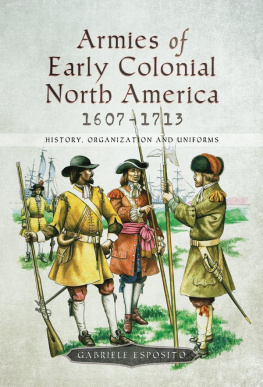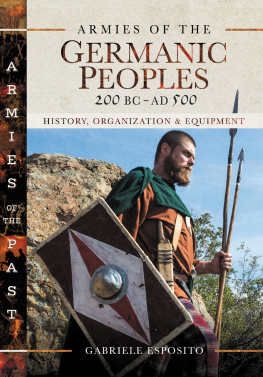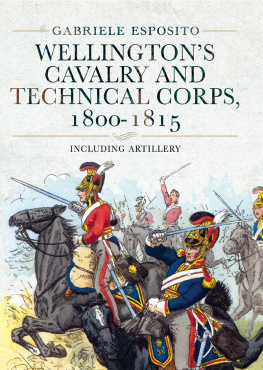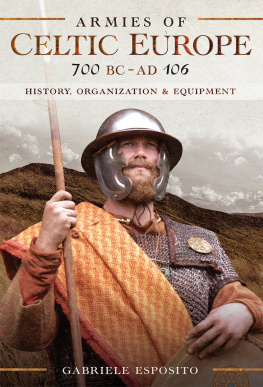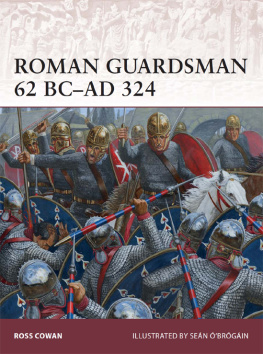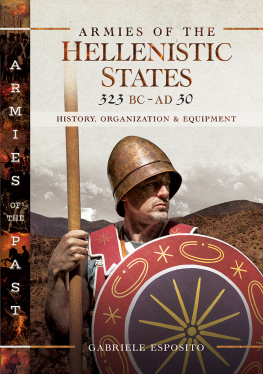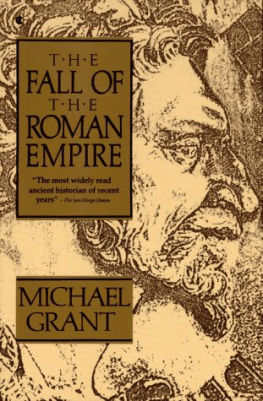Pagebreaks of the print version

Armies of the Late Roman Empire AD 284 to 476
Armies of the Late Roman Empire AD 284 to 476
History, Organization and Equipment
Gabriele Esposito
First published in Great Britain in 2018
by Pen & Sword Military
An imprint of Pen & Sword Books Limited
47 Church Street
Barnsley
South Yorkshire
S70 2AS
Copyright Gabriele Esposito 2018
ISBN 978 1 52673 037 4
eISBN 978 1 52673 038 1
Mobi ISBN 978 1 52673 039 8
The right of Gabriele Esposito to be identified as Author of this Work has been asserted by him in accordance with the Copyright, Designs and Patents Act 1988.
A CIP catalogue record for this book is available from the British Library
All rights reserved. No part of this book may be reproduced or transmitted in any form or by any means, electronic or mechanical including photocopying, recording or by any information storage and retrieval system, without permission from the Publisher in writing.
Pen & Sword Books Limited incorporates the imprints of Atlas, Archaeology, Aviation, Discovery, Family History, Fiction, History, Maritime, Military, Military Classics, Politics, Select, Transport, True Crime, Air World, Frontline Publishing, Leo Cooper, Remember When, Seaforth Publishing, The Praetorian Press, Wharncliffe Local History, Wharncliffe Transport, Wharncliffe True Crime and White Owl.
For a complete list of Pen & Sword titles please contact
PEN & SWORD BOOKS LIMITED
47 Church Street, Barnsley, South Yorkshire, S70 2AS, England
E-mail:
Gabriele Esposito is a military historian who works as a freelance author and researcher for some of the most important publishing houses in the military history sector. In particular, he is an expert specializing in uniformology: his interests and expertise range from the ancient civilizations to modern post-colonial conflicts. During recent years he has conducted and published several researches on the military history of the Latin American countries, with special attention on the War of the Triple Alliance and the War of the Pacific. He is among the leading experts on the military history of the Italian Wars of Unification and the Spanish Carlist Wars. His books and essays are published on a regular basis by Osprey Publishing, Winged Hussar Publishing and Libreria Editrice Goriziana; he is also the author of numerous military history articles appearing in specialized magazines like Ancient Warfare Magazine , Medieval Warfare Magazine , Classic Arms & Militaria Magazine , History of War, Guerres et Histoire , Focus Storia and Focus Storia Wars .
Acknowledgements
This book is dedicated to my fantastic and beloved parents, Maria Rosaria and Benedetto, for their immense love and precious support: everything I do is possible only thanks to their constant advice and continuous help. Their intelligence of old professors is always a great guide for me. A very special mention goes to the six groups of re-enactors who contributed with immense generosity to the creation of the present work: without their magnificent photos, this book would not have been the same. In particular I want to express my gratitude to the following re-enactors and groups: Cohors V Baetica Vexillatio from Spain, Cohors Prima Gallica from Spain, Contubernium Primum from Germany, Fectio from the Netherlands (in particular Jyrki Halme from Finland), Felices Seniores from Germany and Septimani Seniores from Spain.
Last but not least, a very special thanks goes to Franois Gilbert, for giving me permission to use his fantastic drawings of the Notitia Dignitatum s shield emblems. Without his generosity this book wont have had the magnificent Appendix I, with all the shields from the Notitia in colour. Franois is a great reenactor of ancient Romes military and his books published by ditions Errance are a must for all the lovers of this period of military history.
Introduction
No other army in the history of the world has ever been studied as the Roman one, especially for the late Republican/early Imperial period: during those decades, the Romans were able to conquer a large part of the Mediterranean world, defeating every kind of enemy and showing a military superiority that the world had never seen before. Like all the military powers in the history of the world, the Roman one lived a long period of decay before its complete dissolution: the main aim of this book is describing the Roman Army during the last centuries of its existence. In doing this we will try to show how the general picture of the Late Roman Army we have is partly wrong: the decline of Rome from the third century AD was political, economical and military, but we will see how the military organization of Rome remained quite effective in several aspects until the end of the Empire. No other army in history can be compared to the Roman one in terms of longevity: created by Romulus in 753 BC together with Rome itself, it continued to live until the deposition of Romulus Augustulus in AD 476 (in the West, while in the East the Roman military traditions continued to survive until the fall of Constantinople in 1453). During this long period of more than a millennium, the Roman Army evolved from the tribal military force of a city-state to a complex and gigantic apparatus of an expansionist republic. With the advent of the Principate, the Roman legions brought the Pax Romana to most of the Mediterranean world, concluding the long expansionist phase in the history of Rome.
After reaching the peak of its power, the Roman world started to experience some serious troubles: the historical process known as the Third Century Crisis saw the simultaneous eruption of several problems, both internal and external. During those turbulent years, the Roman Empire risked disappearing due to civil wars and external attacks. Despite all these difficulties, the Roman civilization was able to survive and adapt itself to the needs of the new historical situation. Diocletian, with the creation of the Tetrarchy, secured the survival of Rome and started a complex period of internal reforms that would change completely the essence of the Roman Empire. The blow of the Third Century Crisis would have been mortal for any other empire in the history of the world, but it was not for Rome. Thanks to its flexibility and adaptation, all the main components of the Empire were able to survive and remain effective, most of all the military. The main objective of this book is to show how the Roman Army changed its nature after the defeats of the third century AD , abandoning the previous traditional way of warfare that had given Rome so many victories. The army that had been forged by Caesar and Augustus, based on the complementary functions of the legiones and auxilia , was in no condition to face the new threats posed by the emerging historical situation: the mass migrations of Germanic peoples and the invasions launched by the centralist Sassanid Empire required new strategic responses in order to be countered in an effective way. For centuries, global military superiority had enabled Rome to expand almost without limits. However, from the fourth century AD , the balance of power gradually changed, obliging the Romans to adopt a defensive attitude in order to protect their Empire and civilization from complete destruction. In the end, we could say that they were quite successful in doing this: for almost two centuries, the invasions of the Germanic peoples were limited as much as possible, while the eastern part of the Empire was able to survive the collapse of the West and later defeat in a defi nitive way the Sassanids. The picture of Late Roman Army that we generally have, decadent and disorganized, is impossible to conciliate with the great results that we have just described: in fact, as we will try to demonstrate in this book, the Roman Army of the latter centuries was far from being a mass of barbaric mercenaries or poor local levies. Until the very last decades of its existence, it remained well organized and equipped, despite having many problems that will obviously be taken into account in the present study. It is the authors hope that this book will help the reader to have a more updated and complete picture of the Late Roman Army, under three main points of view: history, organization and equipment.


